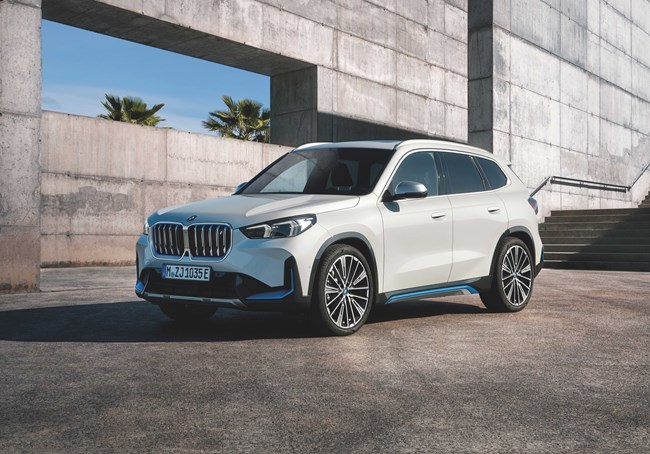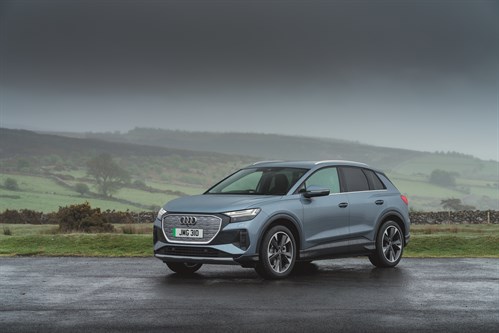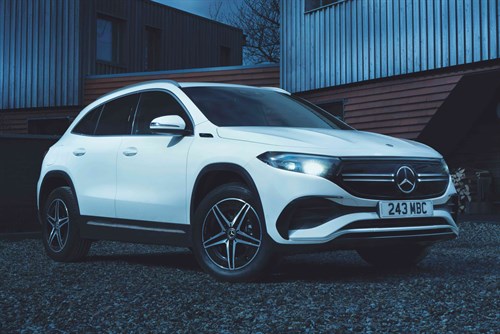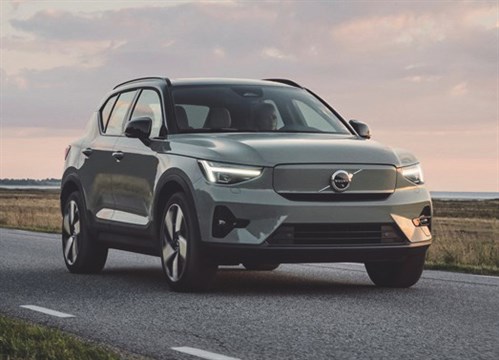We use cookies to ensure that we give you the best experience on our website. If you continue without changing your settings, we will assume that you are happy to receive all cookies on the Business Car website. However, if you would like to, you can change your cookies at any time

The start point for the best source of fleet information |
Best in Class: Electric SUVs
Date: 02 February 2023 | Author: Martyn Collins

BMW iX1
The iX1, which is due imminently, is BMW's most anticipated car in 2023. General manager for corporate sales, Steve Roberts, tells us: "When you look at electric vehicles across the market, the biggest segment is the small SUV."
Sitting on the same new UKL platform as the bigger iX3, the iX1 also benefits from the same longer wheelbase. So, think longer, taller than the old X1 and obviously the overall length has grown too - but is it a bit too close for comfort to the iX3?
Outside, the only way you'll tell the iX1 from its ICE powered siblings is via the badging, as the M Sport version that we're focusing on here looks identical. The styling of the iX1 itself looks familiar, but different. The oversize kidney grilles are memorable, but elsewhere there are slim LED headlights and an aggressive front air dam. At the side, there's sharp wheel arch detailing and flush door handles. The most noticeable design feature at the back of the X1, are the long and high-set, three-dimensional rear light clusters.
The biggest change for the X1 and iX1 is as a result of it being now built on the UKL platform, because this BMW is both longer and taller. Meaning the interior is far more spacious. In the front, the driving position is excellent - with plenty of room and adjustment so even the tallest can get comfortable. Move to the back, and there's more head and legroom than you might expect. The 490-litre boot is slightly smaller than the ICE model but is still practically shaped.
On top of the space, the X1's interior design has taken a similar leap, feeling much more premium - think 2 Series Active Tourer. As with all the recent BMW launches, it's fitted with the latest curved infotainment display - made up of two screens. The infotainment runs BMW's latest OS8 software and is generally easy to use, although you're encouraged to use the voice control system - which doesn't always work. Voice control is all well and good, but we miss physical controls! Elsewhere, the floating centre console houses the gear selection buttons.
The X1 is powered by a range of 48V mild-hybrid, plug-in hybrid, and electric power - we're talking about the latter here. The BMW iX1 xDrive30 is powered by one electric motor at the front axle and another at the rear - equalling four-wheel drive, each combined with power electronics and transmission in a single, compact housing. The drive units deliver a combined output of 313hp (including temporary boost) and overall torque of 494Nm.
The iX1 also benefits from BMW's fifth generation eDrive technology, so its 64.7kWh high-voltage battery, which is positioned in the car's underbody, means that BMW are quoting a range of up to 270 miles. Also, when it comes to charging, the iX1's combined unit allows single and three phase AC charging up to 11kW, which can be optionally increased to 22kW (three-phase AC). As such, the battery can be fully recharged from empty to full in 6.5 hours - or 3 hours 45 minutes as an option. DC charging up to 130kW, also means the iX1 can be charged from 10-80% in 29 minutes, or the range can be increased by 75 miles in an incredible ten minutes.
BMW tells us that early corporate demand for the iX1 is split evenly between the X Line and M Sport models. We've decided to focus on the M Sport, due to its more road-focused look and higher level of standard equipment.
All these EV models share the same 2% BIK figure, but the BMW matches the Mercedes for the 20% monthly figure, just ahead of the Audi and Volvo - at 40% the Mercedes has a narrow advantage.
Any EV with a range of over 250 miles to a charge, is at the top of the fleet car pile in our opinion. The BMW boasts a more than respectable 267 mile range. Impressive though this is, the iX1's range is equalled by the Mercedes, with the Volvo not far behind (259 miles), but it's the Audi that comes top (303 miles).
German brands, such as BMW, have always tended to perform well when it comes to residuals, yet according to our figures from Key Resources, the BMW's at 48.36%, the Audi at 47% and Mercedes 44.33% figure, are all behind the oldest model here, the Volvo at 48.38%.
The iX1 might not have the best residuals, but according to our figures it is the slowest depreciator here, with a £28,351 figure. The Volvo is next, with the Mercedes in third and the Audi in last place.
BMW iX1 xDrive M Sport
P11D: £54,905
CO2 (tax): 0g/km (2%)
BIK 20/40% a month: £18/£37
Range: 267 miles
National Insurance: £495.79
First year VED: £0
Subsequent VED: £0
Battery size/power: 64.7kWh/313hp
AFR: 5p
Residual value: 48.36%
Depreciation: £28,351
Fuel costs: £4,943
SMR: £2,358
Cost per mile: 59.42p

Audi Q4 e-Tron
The Q4 e-Tron is Audi's first mass-market EV and at launch, it were predicting it would be its second best-selling model in the UK. Despite ongoing production issues, we're seeing more of them on UK roads and would be surprised if this wasn't the case now coming up to its second full year on-sale.
What you get is a sister car to the Volkswagen ID.4, Skoda Enyaq iV and the Cupra Born. So, think the same Volkswagen Group MEB dedicated electric platform and similar 52kWh, 77kWh, or range-topping 50 version that we're covering here, with 299hp, 295 miles of range and the addition of an extra front-mounted motor.
The Q4 e-Tron might seem conventional, but it has an unusually squared-off look. A curvier body may be more attractive, but rear headroom and boot space are compromised.
Inside, the dashboard design is similar to other current Audi models, with the 11.6in touchscreen dominating the centre console. There's plenty of head and legroom and the 520 litres of boot space matches the Q5, too.
On the road, with almost 300hp, the Q4 e-Tron is swift and has plenty of grip thanks to the Quattro four-wheel drive.
The Audi is one of the most powerful EVs in the group and has the highest range at 303 miles, 36 miles ahead of the BMW and Mercedes. The £2,346 SMR figure is only just behind the BMW at £2,358, but both are some way off the Volvo XC40. The rest of the Audi's figures are close to the other cars in this group, but it only finishes in fourth place here.
Audi Q4 e-Tron 50 S Line
P11D: £58,355
CO2 (tax): 0g/km (2%)
BIK 20/40% a month: £19/£39
Range: 303 miles
National Insurance: £526.95
First year VED: £0
Subsequent VED: £0
Battery size/power: 82kWh /295hp
AFR: 5p
Residual value: 47.00%
Depreciation: £30,926
Fuel costs: £5,157
SMR: £2,346
Cost per mile: 64.04p

Mercedes-Benz EQA
The EQA is basically an electrified version of the GLA SUV. Underneath, there is a 66.5kWh battery pack, while outside you'll spot the light bar across the front and the sealed grille.
Most similar in size to the Volvo XC40, inside the driving position is excellent, with plenty of adjustment for the seats and steering column. Elsewhere, there's the same metal-edged air vent seen in other Mercedes models - plus a standard 10in digital driver display that takes care of the instruments and sat-nav. The EQA has the most attractive interior of all the cars here, and in AMG Line form is well-equipped.
The EQA models are the 250+, 300 and the range-topping 350 that we have here. Unremarkable to drive, the EQA's steering, and brakes lack feel, there's more body roll than you might expect, the ride is unsettled and considering EVs usually feel willing from the off, this Mercedes is more muted.
The Mercedes has the second highest 267-mile range and second lowest SMR (£2,037). However, it's the £491.73 National Insurance (NI) figure that's the best here, but it is only around £4 better than the BMW.
As for the EQA's cost-per mile figure, at 62.36p, this puts it in third place overall behind the Volvo.
Mercedes-Benz EQA 350 4MATIC AMG Line
P11D: £54,455
CO2 (tax): 0g/km (2%)
BIK 20/40% a month: £18/£36
Range: 267 miles
National Insurance: £491.73
First year VED: £0
Subsequent VED: £0
Battery size/power: 66.5kWh/288hp
AFR: 5p
Residual value: 44.35%
Depreciation: £30,303
Fuel costs: £5,080
SMR: £2,037
Cost per mile: 62.36p

Volvo XC40
The XC40 is the oldest model here, having originally been launched with ICE in 2017.
However, the all-electric XC40 Recharge twin-engine model that we're focusing on here was released in 2020. It is powered by a 78kWh battery, which feeds two electric motors on both axles, equalling four-wheel drive, 408hp and a mighty 660Nm of torque. Considering the performance and 4.7-second acceleration, it's hard to believe this Volvo still has a 2% BIK figure and 257-mile range.
Considering the performance, like the ICE models, the XC40 Recharge is easy to drive. The steering is accurate, and the handling surprisingly agile. It even rides well considering the large alloy wheels and extra weight of the battery.
Plus trim isn't at the top of the range, but it still includes 18in alloys and LED headlights. You also get BLIS and Cross Traffic Alert and Rear Collision Warning, Pilot Assist, adaptive power steering, front and rear parking sensors and a 9in centre display.
The Volvo is the second most expensive to buy here, with its £56,945 P11D figure, but has the best SMR figure of £1,619. The XC40's also tops the residual values with 48.38% figure and is second to the BMW when it comes to depreciation, with its £29,394 figure. The strong performance in key areas has resulted in the Volvo's impressive second-place performance - just behind the BMW.
Volvo XC40 Recharge Twin Plus
P11D: £56,945
CO2 (tax): 0g/km (2%)
BIK 20/40% a month: £19/£38
Range: 259 miles
National Insurance: £514.21
First year VED: £0
Subsequent VED: £0
Battery size/power: 78kWh/402hp
AFR: 5p
Residual value: 48.38%
Depreciation: £29,394
Fuel costs: £5,907
SMR: £1,619
Cost per mile: 61.53p











